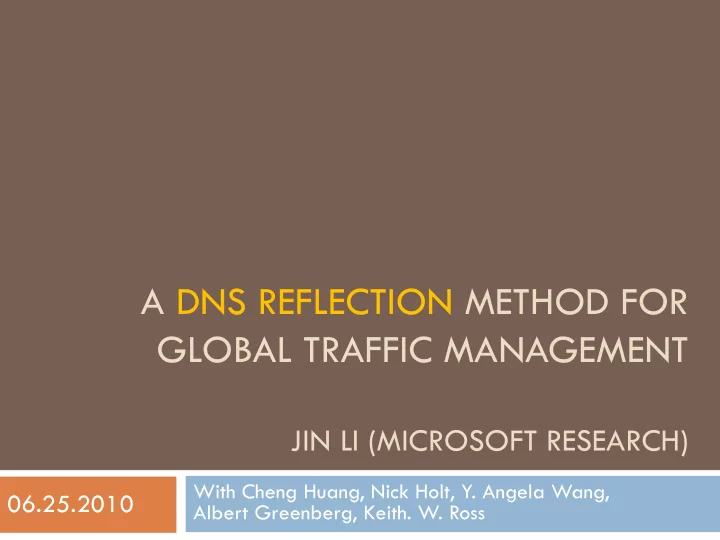

A DNS REFLECTION METHOD FOR GLOBAL TRAFFIC MANAGEMENT JIN LI (MICROSOFT RESEARCH) With Cheng Huang, Nick Holt, Y. Angela Wang, 06.25.2010 Albert Greenberg, Keith. W. Ross
Outline Introduction DNS based GTM GTM optimization, LDNS population & reachability DNS reflection Results Conclusion
Global Traffic Management (GTM) The GTM problem For any service running in N satellite data centers, which data center should be selected to serve a particular client to achieve the best (latency and/or throughput) performance? Cloud storage Content distribution Mega DC (SJC) Dynamic web acceleration Front Load … … Satellite DC Balancer Door AS2 (SEA) Private Mega DC AS1 WAN (NYC) Load Front … Satellite DC AS3 Door Balancer (AMS)
Global Traffic Management (GTM) Practical GTM solutions: how to redirect? HTTP redirection URL rewriting DNS-based GTM All clients resolve the same hostname (e.g., gtm.CloudService.com) GTM returns the IP of the best DC Based on clients’ Local DNS servers (LDNS) GTM never sees clients’ IPs Most common – highly scalable What we deal with in this paper
DNS based GTM CloudService.com Authoritative DNS Mega DC (SJC) Client LDNS Front Load … Satellite DC Balancer Door AS2 (SEA) Private Mega DC AS1 WAN (NYC) Load Front … Satellite DC AS3 Balancer Door (AMS) Client Mega DCs Wide Area Last mile network access Backhaul and BGP peering network
DNS-based GTM solutions Geography-based GTM Decision based on geographic location Mapping from location to DC Anycast-based GTM Serving clients from the anycast-closest DC Anycast (BGP)- closest ≠ latency -closest
DNS-based GTM solutions Passive measurement Monitor performance between IP prefix and DCs Most clients directed to the best DC Some clients (randomly selected) directed to probe other DCs Traces captured at DCs to infer performance Major problem Performance of the selected clients is degraded LDNS caching will affect subsequent clients and can be very bad Active probing Most often used by CDN See next slide for reachability
Reachability of LDNS 6 week’s logging of 5% NCSI DNS traffic 795K unique LDNSes in 10,012 cities and 229 countries
Reachability of LDNS Monitor performance between LDNS and DC Active probing 49% Ping-able another 6% respond to DNS probe queries For the rest 45% – passive measurement w/ DNS traffic Trigger DNS query from arbitrary LDNS to measure any target DC through DNS Reflection Passive measurement no LDNS query, no measurement Universal applicable to any LDNS Minimize performance impact always serve clients with the optimal DCs Achieve high accuracy
Our proposal – DNS Reflection GTM using DNS Reflection Minimize performance impact Achieve high accuracy How does it work? How does the solution fare with existing ones?
DNS Reflection Method The key is to trigger a LDNS query the same DC twice
Evaluation How accurate is the measurement? How good is reflection based GTM fare with geography & anycast based GTM? Prototype deployed on 17 DCs in the Microsoft global data center network 162 (out of 274) PlanetLab nodes LDNS co-locates with client (240) LDNS responds to Ping (162)
Accuracy – DNS Reflection vs. Ping DNS reflection matches very well with Ping 6 ms away from Ping
GTM Performance GTM using DNS Reflection is very close to optimal 2 ms away from optimal vs. 74 ms (geography) and 183 ms (anycast)
Conclusion DNS-based GTM is most commonly used Active probing suffers from limited reachability Passive measurement by redirecting clients to sub- optimal DCs degrade performance and affect subsequent clients DNS Reflection method Cause a minimal performance impact Achieve high accuracy
Recommend
More recommend